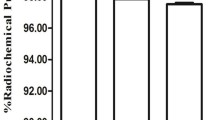Abstract
Purpose
Due to the shortage of established platforms/methods for multimodality probe construction, in this study, we developed a heterofunctional chelator, BaAn(Boc)Sar, from sarcophagine cage as a general platform for dual-modality probe construction.
Procedures
A dual-modality probe for positron-emission tomography (PET) and fluorescence imaging was synthesized using the developed BaAn(Boc)Sar chelator. The c(RGDyK)2 peptide (denoted as RGD2) and fluorescence dye Cy5.5 were conjugated with BaAn(Boc)Sar to form BaAnSar-RGD2-Cy5.5. Then, BaAnSar-RGD2-Cy5.5 was labeled with 64Cu in ammonium acetate buffer. PET and fluorescent imaging were carried out to evaluate 64Cu-BaAnSar-RGD2-Cy5.5 in nude mice bearing U87MG glioblastoma xenograft.
Results
The BaAnSar-RGD2-Cy5.5 was labeled with 64Cu very efficiently in 0.1 M NH4OAc buffer within 10 min at 37 °C in the yield of 86.7 ± 4.4 % (n = 3). The specific activity of 64Cu-BaBaSar-RGD2 was controlled at 50–200 mCi/μmol for the consideration of both PET and optical imaging. MicroPET quantification analysis shows that the U87MG tumor uptake is 6.41 ± 0.28, 6.51 ± 1.45, and 5.92 ± 1.57 %ID/g at 1, 4, and 20 h postinjection, respectively. Good correlation was obtained between the tumor to muscle ratios measured by the radioactivity and fluorescence intensity. As a proof of concept, an animal surgery study demonstrated that this dual-modality probe would greatly benefit the patients because the PET moiety could be used for tumor detection, and the fluorescent moiety would allow image-guided surgery.
Conclusions
Our findings demonstrated the effectiveness and feasibility of preparing dual-modality imaging probes based on the sarcophagine scaffold. The resulting PET and fluorescent imaging probe also holds a great potential for clinical translation.






Similar content being viewed by others
References
Margolis DJ, Hoffman JM, Herfkens RJ, Jeffrey RB, Quon A, Gambhir SS (2007) Molecular imaging techniques in body imaging. Radiology 245:333–356
Hoffman JM, Gambhir SS (2007) Molecular imaging: the vision and opportunity for radiology in the future. Radiology 244:39–47
Massoud TF, Gambhir SS (2003) Molecular imaging in living subjects: seeing fundamental biological processes in a new light. Genes Dev 17:545–580
Ye Y, Chen X (2011) Integrin targeting for tumor optical imaging. Theranostics 1:102–126
Cheon J, Lee JH (2008) Synergistically integrated nanoparticles as multimodal probes for nanobiotechnology. Acc Chem Res 41:1630–1640
Zhang Y, Yang Y, Cai W (2011) Multimodality imaging of integrin αvβ3 expression. Theranostics 1:135–148
Nahrendorf M, Keliher E, Marinelli B, Waterman P, Feruglio PF, Fexon L et al (2010) Hybrid PET-optical imaging using targeted probes. Proc Natl Acad Sci USA 107:7910–7915
Gupta T, Master Z, Kannan S, Agarwal JP, Ghsoh-Laskar S, Rangarajan V et al (2011) Diagnostic performance of post-treatment FDG PET or FDG PET/CT imaging in head and neck cancer: a systematic review and meta-analysis. Eur J Nucl Med Mol Imaging 38:2083–2095
Santra A, Kumar R, Reddy R, Halanaik D, Bal CS, Malhotra A (2009) FDG PET-CT in the management of primary breast lymphoma. Clin Nucl Med 34:848–853
Stummer W, Pichlmeier U, Meinel T, Wiestler OD, Zanella F, Reulen HJ (2006) Fluorescence-guided surgery with 5-aminolevulinic acid for resection of malignant glioma: a randomised controlled multicentre phase III trial. Lancet Oncol 7:392–401
Beer AJ, Kessler H, Wester HJ, Schwaiger M (2011) PET imaging of integrin αvβ3 expression. Theranostics 1:48–57
Liu S, Li Z, Yap LP, Huang CW, Park R, Conti PS (2011) Efficient preparation and biological evaluation of a novel multivalency bifunctional chelator for 64Cu radiopharmaceuticals. Chemistry 17:10222–10225
Cai H, Li Z, Huang CW, Park R, Shahinian AH, Conti PS (2010) An improved synthesis and biological evaluation of a new cage-like bifunctional chelator, 4-((8-amino-3,6,10,13,16,19-hexaazabicyclo[6.6.6]icosane-1-ylamino)methyl) benzoic acid, for 64Cu radiopharmaceuticals. Nucl Med Biol 37:57–65
Cai H, Li Z, Huang CW, Shahinian AH, Wang H, Park R et al (2010) Evaluation of copper-64 labeled AmBaSar conjugated cyclic RGD peptide for improved microPET imaging of integrin αvβ3 expression. Bioconjug Chem 21:1417–1424
Cai H, Fissekis J, Conti PS (2009) Synthesis of a novel bifunctional chelator AmBaSar based on sarcophagine for peptide conjugation and 64Cu radiolabelling. Dalton Trans:5395–5400
Cai H, Li Z, Huang CW, Park R, Conti PS (2011) 64Cu labeled AmBaSar-RGD2 for micro-PET imaging of integrin αvβ3 expression. Curr Radiopharm 4:68–74
Phelps ME (2000) Positron emission tomography provides molecular imaging of biological processes. Proc Natl Acad Sci USA 97:9226–9233
Frangioni JV (2003) In vivo near-infrared fluorescence imaging. Curr Opin Chem Biol 7:626–634
Li Z, Jin Q, Huang CW, Dasa S, Chen L, Yap LP et al (2011) Trackable and targeted phage as positron emission tomography (PET) agent for cancer imaging. Theranostics 1:371–380
Di Bartolo NM, Sargeson AM, Donlevy TM, Smith SV (2001) Synthesis of a new cage ligand, SarAr, and its complexation with selected transition metal ions for potential use in radioimaging. J Chem Soc Dalton 1:2303–2309
Liu S, Liu H, Jiang H, Xu Y, Zhang H, Cheng Z (2011) One-step radiosynthesis of 18F-AlF-NOTA-RGD for tumor angiogenesis PET imaging. Eur J Nucl Med Mol Imaging 38:1732–1741
Acknowledgments
This work was supported by the Department of Energy (DE-SC0002353), the National Cancer Institute (P30CA014089), the American Cancer Society (121991-MRSG-12-034-01-CCE), National Natural Science Foundation of Guangdong (no. U1032002), National Natural Science Foundation of China (no.81071206), and the USC Biomedical Imaging Science Initiative.
Conflict of Interest
The authors have declared that they have no conflict of interest.
Author information
Authors and Affiliations
Corresponding authors
Rights and permissions
About this article
Cite this article
Liu, S., Li, D., Huang, CW. et al. Efficient Construction of PET/Fluorescence Probe Based on Sarcophagine Cage: An Opportunity to Integrate Diagnosis with Treatment. Mol Imaging Biol 14, 718–724 (2012). https://doi.org/10.1007/s11307-012-0557-z
Published:
Issue Date:
DOI: https://doi.org/10.1007/s11307-012-0557-z




